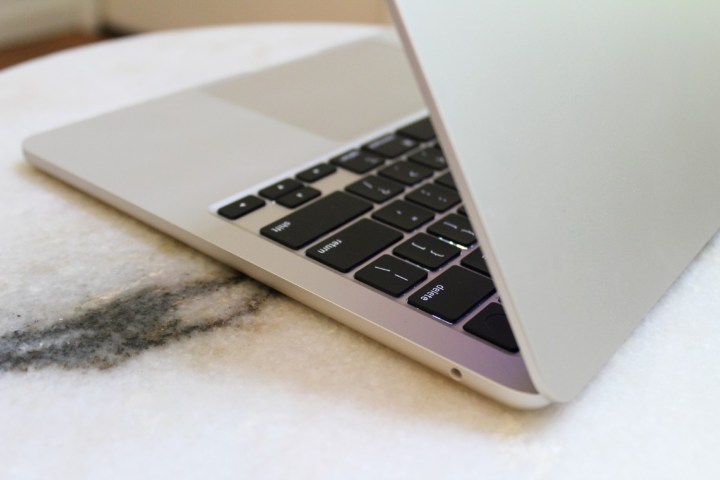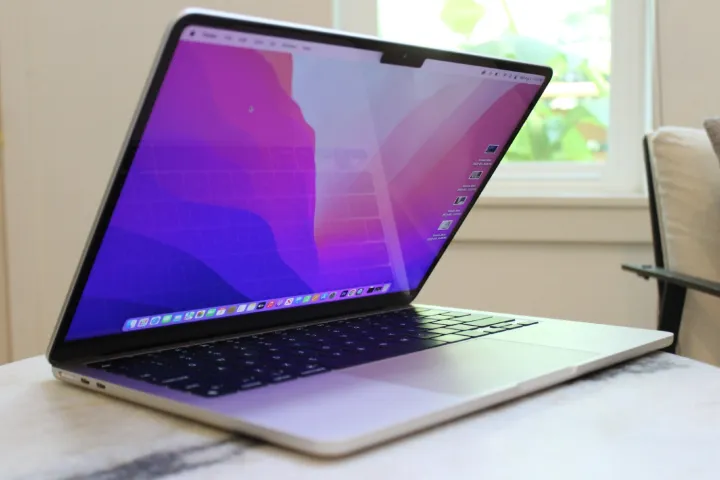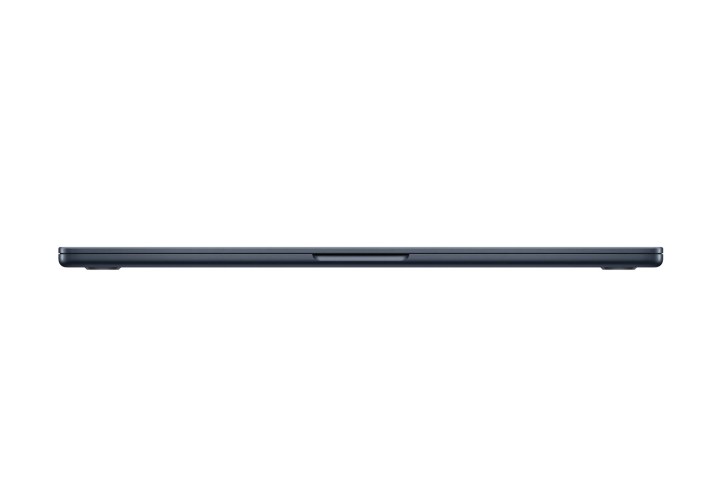Apple revamped the MacBook Air with the MacBook Air 13 M2 model, replacing the iconic tapered chassis design with one that more closely mimics the latest MacBook Pros. But it kept true to the “Air” moncker by making the new model the thinnest 13-inch laptop you can buy and keeping it incredibly light.
Now, the MacBook lineup has a new member. The MacBook Air 15 uses the same M2 processor as its smaller sibling and the same IPS Liquid Retina display technology, but the new panel is larger while the chassis remains almost as thin. Given likely equal performance and display quality, it all comes down to size. Do you want a smaller laptop that’s easier to carry around or the extra screen real estate?
Specs
| Apple MacBook Air 15 | Apple MacBook Air 13 | |
| Dimensions | 13.40 inches x 9.35 inches by 0.45 inches | 11.97 inches x 8.46 inches x 0.44 inches |
| Weight | 3.3 pounds | 2.7 pounds |
| Processor | Apple M2 | Apple M2 |
| Graphics | Integrated | Integrated |
| RAM | 8GB 16GB 24GB |
8GB 16GB 24GB |
| Display | 15.3-inch 16:10 Liquid Retina IPS 2,880 x 1,864 | 13.6-inch 16:10 Liquid Redina IPS 2,560 x 1,664 |
| Storage | 256GB SSD 512GB SSD 1TB SSD 2TB SSD |
256GB SSD 512GB SSD 1TB SSD 2TB SSD |
| Touch | No | No |
| Ports | 2 x USB-C with Thunderbolt 4 1 x 3.5mm audio jack |
2 x USB-C with Thunderbolt 4 1 x 3.5mm audio jack |
| Wireless | Wi-Fi 6 and Bluetooth 5.3 | Wi-Fi 6 and Bluetooth 5.3 |
| Webcam | 1080p | 1080p |
| Operating system | MacOS Monterey | MacOS Monterey |
| Battery | 66.5 watt-hour | 52.6 watt-hour |
| Price | $1,300+ | $1,100+ |
| Rating | Not yet reviewed | 4 out of 5 stars |
Apple dropped the price of the MacBook Air 13 by $100 to make room for the larger model, bringing it to $1,100 for an 8-core CPU/8-core GPU M2, 8GB of RAM, a 256GB SSD, and a 13.6-inch Liquid Retina IPS display. The most you’ll spend is $2,400 for an 8-core CPU/10-core GPU M2, 24GB of RAM, and a 2TB SSD.
The MacBook Air 15 is slightly more expensive. You can start with an 8-core CPU/10-core GPU M2 (the only option), 8GB of RAM, a 256GB SSD, and a 15.3-inch Liquid Retina IPS display for $1,300. Fully configured, the laptop costs $2,500 for 24GB of RAM and a 2TB SSD, just $100 more than the 13-inch model.
Note that you can still buy the older MacBook Air M1, and you’ll save $200 at the entry level by sticking with the older technology. Given the improvements in design and performance, though, we don’t consider it a legitimate competitor to the MacBook Air 15, so we’ll leave it out of this comparison.
Design

The MacBook Air 15 looks exactly like the 13-inch model, only stretched out in width and depth. It’s almost as thin at 0.45 inches compared to 0.44 inches, making it the thinnest 15-inch laptop around. It adds about half a pound, at 3.3 pounds versus 2.7 pounds, meaning both are very light for their respective sizes. And both have the elegant, boxier look of the new MacBook line, with just the right angles and an aesthetic that doesn’t need any bling to make it incredibly attractive. Both laptops are available in Silver, Space Gray, Starlight, and Midnight color schemes.
The MacBook Air 13 is incredibly well-built, like all MacBooks, but due to its incredibly thin chassis, the lid does demonstrate some uncharacteristic bending. We haven’t tested the MacBook Pro 15 yet, but we imagine we’ll find the same thing.
Both laptops share the same connectivity, with just two Thunderbolt 4 ports and an audio jack. The MagSafe 3 power connector on both not only saves a Thunderbolt 4 port for connectivity, but easily pops off if snagged. Both laptops also list Wi-Fi 6 in their specifications, which is a generation behind the faster Wi-Fi 6E, but both have the latest Bluetooth 5.3.
The both also share the same limitation in external display support. The M2 CPU only handles a single external monitor, at up to 6K at 60Hz. That’s a significant limitation compared to most Windows laptops, as well as the more powerful MacBook Pro 14, but it makes no difference in this comparison.
The 1080p webcam is an upgrade over earlier models, and both laptops use the same technologies to create a superior video image for videoconferencing. You’ll also find Touch ID embedded in the power button on both machines.
Performance

The MacBook Air 13 can be equipped with the slower 8-core CPU/8-core GPU M2 processor, with the 8-core CPU/10-core GPU M2 as an upgrade option. The MacBook Air 15 uses only the latter. Most likely, you’ll find performance to be quite similar with both machines, although thanks to a larger chassis, the MacBook Air 15 might be slightly faster.
We’ve provided some benchmark results from the MacBook Air 13 in the table below, but we’ll have to wait until we’ve completed our review to provide similar numbers for the 15-inch model. These results are solid for both demanding productivity and lightweight creativity work, which is exactly what the laptops aim to provide.
| Geekbench (single / multi) |
Handbrake (seconds) |
Cinebench R23 (single / multi) |
Pugetbench Premiere Pro |
|
| MacBook Air 13 M2 (M2 8/10) |
1,925 / 8,973 | 151 | 1,600 / 7,938 | 497 |
Display

The MacBook Air 13 and 15 both utilize the same Liquid Retina IPS technology, and so they should provide similar performance. The MacBook Air 15’s panel is 15.3 inches at 2,880 x 1,864, and it provides similar sharpness to the MacBook Air 13’s 13.6-inch display at 2,560 x 1,664.
While it’s not as great a display as the Mini-LED panels on the MacBook Pro models, the MacBook Air 13 still provides excellent brightness, colors, and good contrast for any technology not called Mini-LED or OLED. It’s a display that will please producers, creators, and media consumers alike, and we imagine the MacBook Air 15 will offer more of the same, only with more room for multitasking.
| MacBook Air 13 (IPS) |
|
| Brightness (nits) |
486 |
| AdobeRGB gamut | 100% |
| sRGB gamut | 90% |
| Accuracy (DeltaE, lower is better) |
1.08 |
| Contrast ratio | 1,310:1 |
One area where the MacBook Air 15 holds an advantage is in its six-speaker setup with force-canceling woofers. It’s likely to provide significantly better audio than the four-speaker setup in the MacBook Air 13.
Portability

As mentioned previously, both laptops are almost equally thin, and they’re both very light. The MacBook Air 15 is larger in width and depth, of course, meaning it will take up more room in your backpack. But you’ll barely feel it.
In terms of battery life, Apple estimates up to 18 hours of movie playback and up to 15 hours of wireless web use with both laptops. We’ll be looking forward to seeing if the 15-inch model can live up to the excellent battery life of the smaller machine.
It all comes down to size
The MacBook Air 13 and MacBook Air 15 will likely perform the same, have equally good display quality, and provide the same solid, attractive aesthetic. And they’re pretty close in price as well.
So, it all comes down to whether you want one of the most portable 13-inch models around, or you want the extra screen real estate of the MacBook Air 15. In both cases, you’ll get a good-performing laptop with great battery life.
Editors’ Recommendations
Services Marketplace – Listings, Bookings & Reviews